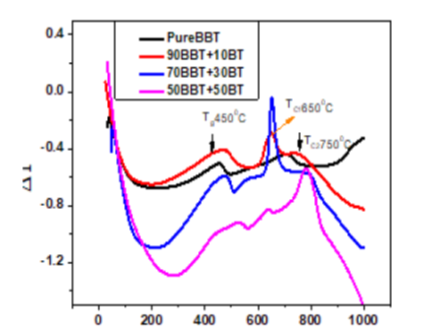


Indian Journal of Science and Technology
Year: 2022, Volume: 15, Issue: 17, Pages: 839-849
Original Article
T Sravan Rao1, N V Prasad1, Md Shareefuddin1, G Prasad1*
1Materials Research Laboratory, Department of Physics, Osmania University, 50007, Hyderabad, India
*Corresponding Author
Email: [email protected]
Received Date:28 February 2022, Accepted Date:15 March 2022, Published Date:19 May 2022
Objectives: In the present investigation, transparent novel glass embedded with ferroic matrix was prepared by melt-quenching method. Among all the glasses, selective glass ceramic is also prepared. Optical and electrical measurements were carried out on the samples. Methods: We have prepared the transparent glass composition of (100-x)[0.55Bi2O3-0.30B2O3-0.15TiO2] +xBaTiO3 ; with x=0, 10, 20, 30, 40, 50 wt.%. Appropriate amounts of reactant mixture were well mixed in agate mortar and melted in a porcelain crucible. The composition is quickly quenched by pouring on pre-heated stainless-steel plate and pressed with another plate. Differential Thermal Analysis was made on the glasses. Detailed optical absorption and impedance measurements were made on the said above glass matrix. Findings: From the XRD spectra, amorphous and crystalline nature was established on the glass and glass ceramic sample. Optical absorption spectra show that with increasing the BaTiO3 in the glass matrix, it results into structural compactness by means of non-bridging oxygen. The results are consistent with the oxygen packing density values. Impedance spectroscopic plots have shown broad peaks and therefore these materials are being considered as special type multicomponent glass ceramics. Disorder nature of the samples was also discussed with the help of dc-conductivity plots. Among all the samples, 60-BBT-40BT has shown broad spectroscopic peak. Therefore, this sample was annealed at 700oC, and the XRD pattern resembles with Bi4Ti3O12 Aurivillius phase, instead of BaTiO3 phase. Detailed impedance measurements were also made on the glass ceramic. Novelty: Dielectric ceramic-glass are being used to fabricate energy storage capacitors; however, further studies are needed in order to improve pore-free microstructures. In view of this, transparent glass matrices are embedded with ferroic materials namely BaTiO3 and the combined optical and electrical results would be useful for future promising optoelectronic materials by means of oneto- many applications.
Keywords: Ferroelectric; glassceramics; optical absorption; impedance; dielectric; FTIR
© 2022 Rao et al. This is an open-access article distributed under the terms of the Creative Commons Attribution License, which permits unrestricted use, distribution, and reproduction in any medium, provided the original author and source are credited.
Published By Indian Society for Education and Environment (iSee)
Subscribe now for latest articles and news.